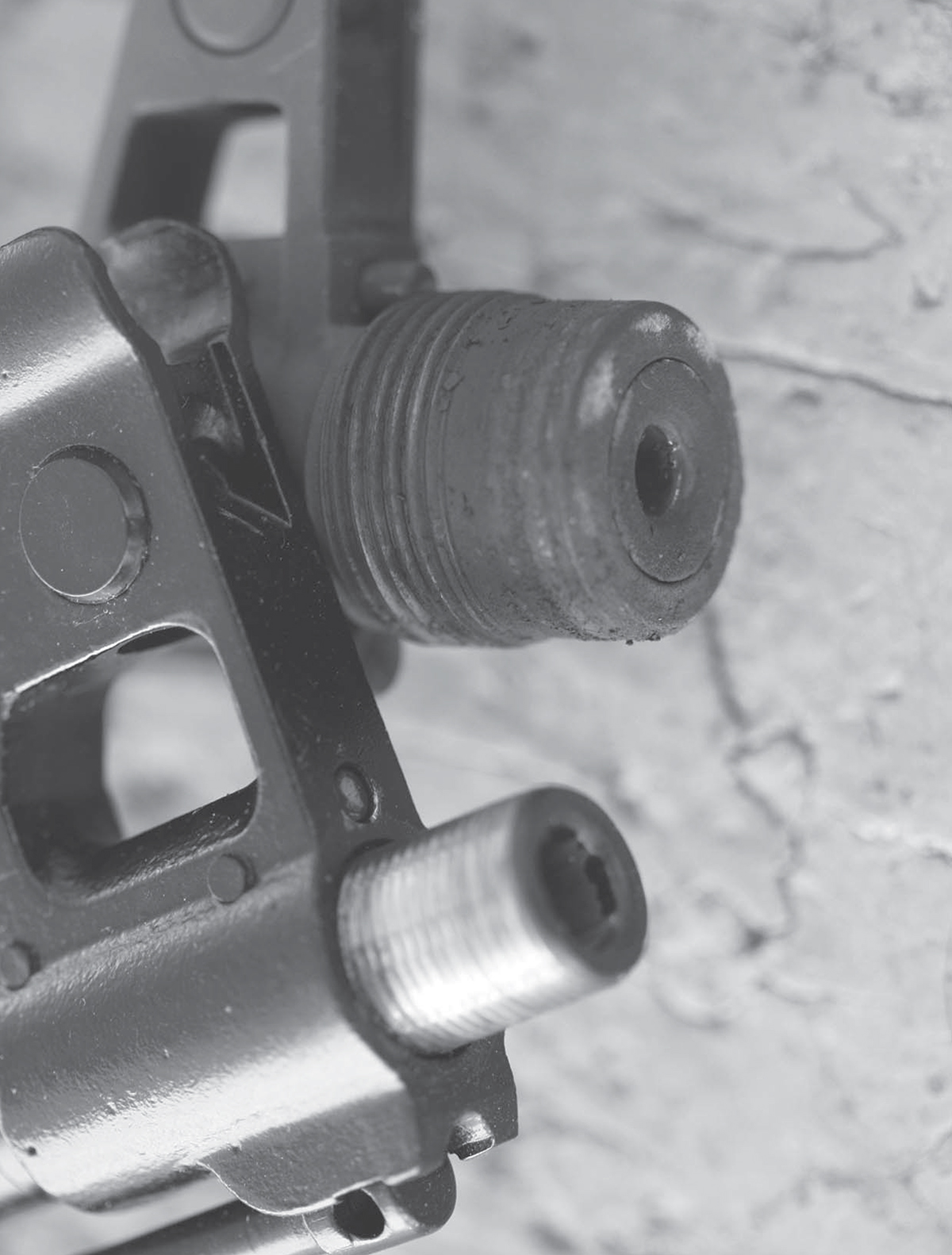
The difference in threads between the AK-47 and AK-74 is obvious once you take off their respective muzzle devices.
A SUPPRESSOR CAN BE MOUNTED ON AN AK, the Soviets just didn’t make it very easy to do. Then again, back when the rifle was being designed, no one had a clue how common suppressors would be today. The problems with mounting a suppressor on the AK come down to three things: threads, barrel diameter, and gas system.
The threads on the AK-47 were meant to hold the slant brake on, period. The AK-74 uses a front sight casting that is threaded to attach the body of the muzzle brake. These threads are metric and left-handed. (As if just one of those wasn’t problem enough.) The AK-47 thread pattern is M14x1L — that is, 14 millimeters in diameter, one thread per millimeter of pitch.
The designation pattern is, “M” for metric, a numeral for the nominal diameter, the multiplication sign to separate it from the pitch, and then the pitch in millimeters. Of course, the world of dimensions being what it is, there is a coarse pitch and a fine pitch, plus-and-minus for thread tolerances, and the material that is threaded has specifications for hardness, smoothness, and surface finish.
What the original drawings lacked was a hard-and-fast requirement that the threads be axial and concentric. That is, straight. “Is slant-brake, comrade. Threads are straight enough.”

The difference in threads between the AK-47 and AK-74 is obvious once you take off their respective muzzle devices.
This was no doubt changed when the AK-74 came along, as the brake had to be centered so that the bullet wouldn’t hit the brake. They cut the threads on the front sight housing, and made it large enough so the brake backend was a simple open cylinder with threads on the inside. This made the threaded portion of the mount impossibly large. The threads on the front sight assembly are 24x1.5R, which means they are almost an inch in nominal diameter, but at least they are right-handed. (The Romanians, for reasons known only to them, used 22x1.5R. Go figure.)
This makes both the AK-47 and the 74 problematic. The AK-47 threads, translated to English, are .551 inches x 25.4. That is pretty close to the 1⁄2x28 of the AR-15 muzzle threads, but not quite. And that left-handed part is a real problem. The issue is that those threads are on a .30 caliber barrel and .30-cal. threads for a suppressor; here in ‘Murica, they are typically 5⁄8x24. A standard direct-thread .30 suppressor will slip right over the AK threads and not even touch. You need an adapter, which risks adding even more dimensional misalignment to the system.

Scale this down to a rifle. This is what goes on at the end of your AK that you are trying to contain in a suppressor. M109 firing in Iraq. Photo by Staff Sgt. Cupp
The AK-74 translates to .945 x17. I’m not sure you can even buy an English-dimension tap of that size, you’d have to cut those threads on a lathe. That’s a lot of lathe work, but it can, and has been, done.
Which means you can’t ask a suppressor maker to provide you with a left-hand metric thread direct-thread suppressor, unless you are willing to place an order for enough of them to cover their set-up charges.
No, you have to go with either a conversion adapter or a QD mount. A quick search of the available suppressor makers that came to mind uncovered an AK mount from Gemtech, for their Sandstorm suppressors. And for adapters, I’ve found two sources — Innovative Arms and Mounting Solutions Plus.

It takes extra work to install a suppressor on an AK. Especially the AK-74, where the muzzle brake threads are so wide and odd. It’s best to find another brake and start working on the lathe.
The barrel diameter on the AK-74 is not an issue. The front sight assembly holds the threads, so there’s no problem, right? Well, not like the ’47, but we’ll get to that.
The barrel diameter on the AK-47 is skinny. I just took a pair of digital calipers to an array of my AKs, and the diameters measured from .580 to .630 inches, but the important part is that the threads extend all the way back to the front sight housing. That means there isn’t a shoulder against which the mount or suppressor can bottom out. There is the vertical surface of the front sight housing, and its spring-loaded locking plunger for the slant brake.
You can’t torque the can tight against the rear of the threads, as you can on an AR. If the thought of the threads on an AK muzzle being axial and centered is optimistic, then the hope that the front face of the front sight housing is perpendicular to the axis of the bore is hallucinatory.
The big problem with the barrel on the AK — both the 47 and 74 — is that it is lightweight. That means it flexes when you shoot. I’ve seen enough high-speed video of AKs firing to have noticed how the barrel bends, and springs back and forth. So what’s the problem with that if a suppressor is attached? Well, let’s suppose the barrel has flexed, reaching its maximum deflection just at the moment the bullet exits the muzzle. Once out, the barrel movement can no longer influence the bullet’s path. Can the barrel flex back into the path of the bullet? Good question. A little back-of-the-envelope checking might give us a hint. Let’s assume the barrel flexes 0.010 inches. The suppressor is six inches long. The bullet will leave the suppressor 0.00023 seconds after it leaves the muzzle. The suppressor would have to be vibrating 0.010 inches in 0.00023 seconds, or 12,000 rpm, to move back in the way. So, highly unlikely.
It may not be enough to cause a baffle strike, but it can be enough, considering the added weight of the suppressor, to cause a zero shift. Since that’s what we’re here to test, once we’ve laid out all the details of the situation we’ll test that out.
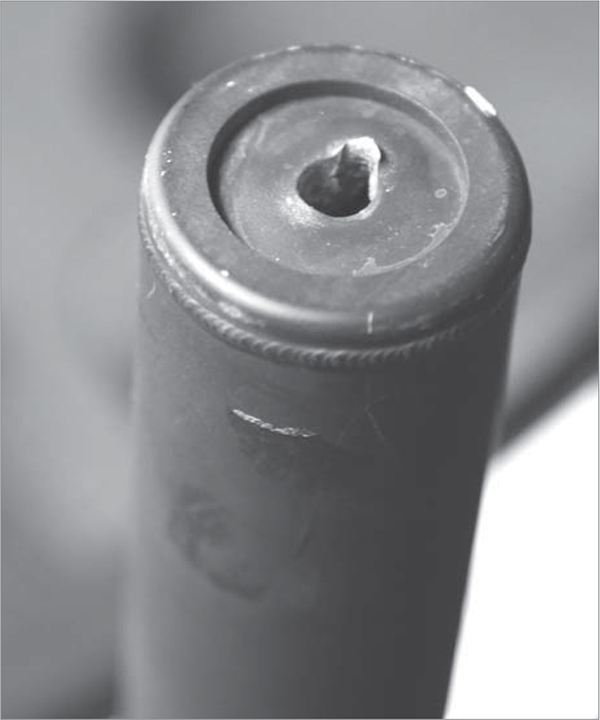
This is what can happen if your suppressor is not properly aligned. Don’t be this guy.
As discussed elsewhere, the AK system is grotesquely over-gassed. From the perspective of an end-user interested in using a suppressor, it vents the excess gas early in the system cycle, when it is still at a relatively high pressure. That limits just how quiet you can make an AK, but you still can make it quieter than it would be otherwise.
The process is pretty simple, even if it is not at all what you’d expect, having worked with ARs and other rifles. The first thing you have to realize is that you have to give up on the usual methods. You are not likely to find a direct thread suppressor with AK threads. So, that means you need an adapter, or a metric-threaded QD mount.
Mounting Solutions Plus makes a threaded muzzle device adapter for the AK. The MDA has 14x1L threads on the inside, and 5⁄8x24R threads on the outside. Here’s the catch: the company cannot, does not, and will not endorse its use with suppressors. The variables are too many, and too great, for them to do anything but say “Nope, no way.”
That’s because of the unknowns involved when removing the slant brake, screwing on the adapter, and torquing it up against the front face of the front sight tower. There are three variables at work here — alignment of the threads, centeredness of the threads, and the squareness of the front sight front face. If any of them is off too far, your bullets will hit your suppressor. If they are all off, you could have your suppressor launched on one shot. Or, they could counteract each other, and you’d end up with a centered suppressor. Mounting Solutions Plus can’t control any of these variables, nor can they predict them. So they rightfully tell you to not try it.
However, if you’re going to try it, use the Geissele Alignment Rod.
Make sure the rifle is unloaded. Install the Mounting Solutions Plus adapter. Slide the Alignment Rod down the bore, screw the suppressor on the adapter. Tilt the rifle, and let the Rod slide forward, out of the suppressor. Stop it as it begins to exit, and study the alignment. Geissele has three classes of alignment: Complete Pass, Partial Fail, Complete Fail. A Complete pass is obvious; the rod passes through the front face of the suppressor in exact centeredness.

Mounting Solutions Plus makes no guarantees, and if something goes wrong they won’t help. You’ve been warned. But you also can measure before you shoot.
With a Complete Pass, you are pretty sure things will work just fine. Yes, the barrel might flex enough to cause a strike, but the odds are more likely that it happens because you don’t keep things tight.
A Partial Fail is where the alignment rod touches the baffle as it passes through, or leaves the front face off-center but not touching. There are some who will accept a not-touching-but-off-center alignment, and be happy. I might, on a rifle with a more rigid barrel. On an AK, I won’t.
A Complete Fail means the suppressor is so misaligned that the rod can’t come all the way out with gravity. Don’t even think about shooting this setup.
So, if you install the Mounting Solutions Plus MDA on your rifle with a suppressor, and you get a Complete Pass, you can go ahead, but neither Mounting Solutions Plus nor I will say it is OK. Just that things line up. And guess what? If you take the very same MDA off that rifle, and install it on the next rifle in your rack, guess what the odds are you’ll get another Complete Pass? That’s right, a roll of the dice. If you find a setup that fits, aligns, and works, stick with it. Don’t go putting it on another rifle, or loaning the parts to your friend. You, or he, might not be so happy soon after.
All that said, if you want to mount an actual flash hider to your AK, the MDA is just the ticket. It’s available in black oxide and stainless steel.
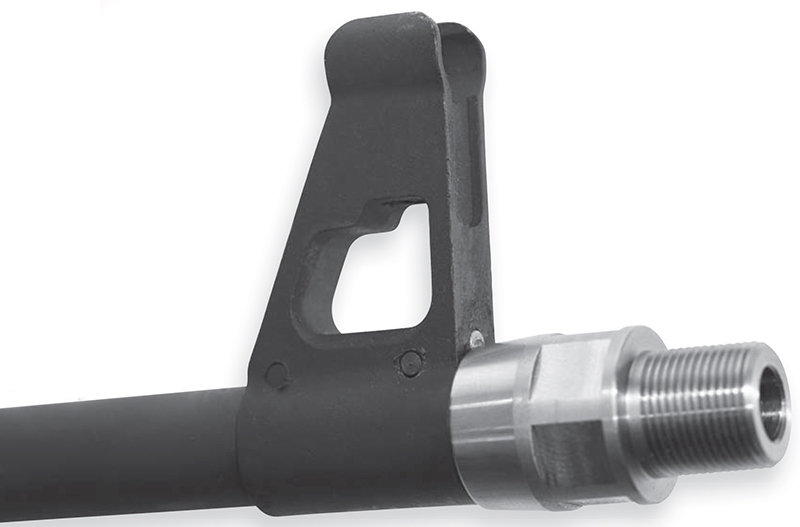
Here is the stainless adapter from Mounting Solutions Plus in place. Will it work? That depends.

It looks right, but looks can be deceiving. Without the Geissele Alignment Rod, you are just guessing. Guessing is bad.
Innovative Arms also makes a dedicated adapter for suppressors on AKs. And, like Mounting Solutions Plus, they make no guarantees. It is up to you to measure, gauge, and check alignment. If things are all centered, have fun. If not, don’t do it. And if you do, don’t say we all didn’t warn you.
The Gemtech mount is a two-lug design for the HVT and Quicksand suppressors. The suppressor rear cap has a socket that is cut to accept the two lugs, which are not of the same size. That way, you can only install the suppressor one way. To install, push the suppressor onto the mount until you feel the spring pressure, then turn to lock and let go. The spring pushes the suppressor forward, and the lugs prevent the suppressor from turning and unlocking. To remove, wait for it to cool (you laugh, but people forget) press the suppressor in (compressing the spring), rotate and pull forward off.
It’s simple, easy, and dependent on the barrel accepting the mount, square and straight. One detail in which the Gemtech mount differs from the adapters is that it is machined to bottom out on the barrel crown, not the front sight housing.

Partial Fail. The Geissele rod is rubbing the front cap edge, and that is not a good sign. I won’t shoot this combo.

The Gemtech two-lug mount bottoms out against the muzzle crown, not the front sight housing.
The first thing to do is to try the adapters and mounts on rifles, with suppressors, and check alignment. The mounts and adapters I’ve mentioned are for two suppressors — the .30 Amtac SBR762, a compact direct-thread, and the Gemtech Quicksand, a primo .30 made with a two-lug rear cap. I tried them on a cross-section of 7.62 AKs; the Century Arms Centurion, Century Arms C39V2, a Hungarian milled receiver AK, IEWI Ace, and as a check back into the mists of time, my Romanian AKM.
The results were all over the map, and laid out below. One thing I found, which was a rather startling surprise, was the radically off-axis threads of the Romanian AK. As mentioned above, Geissele’s Alignment Rod measures three classes of fit — Pass, Partial Fail and Complete Fail. Well, with the Romanian AK we have to add a fourth class: Epic Fail. When it came time to try the rod in the Romy with one of the Mounting Solutions Plus adapters, I could not force the rod fully into the suppressor and bore. Well, at least not without bending the rod more than I felt was wise. Look closely at the photo. At that point, I could point the rifle straight down and shake it, and the rod would not fall out. Ouch. 
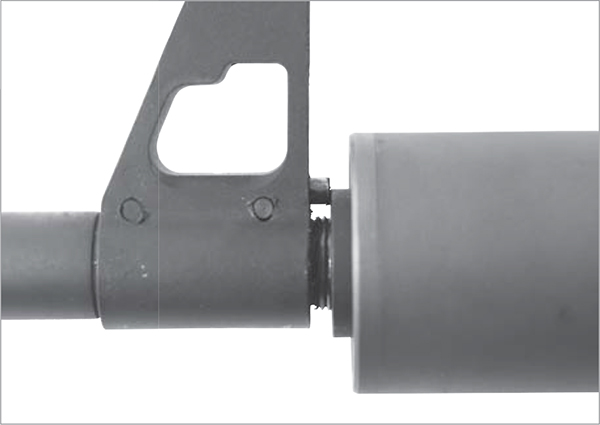
Note the gap between the Gemtech mount and the front sight. This is supposed to be this way.
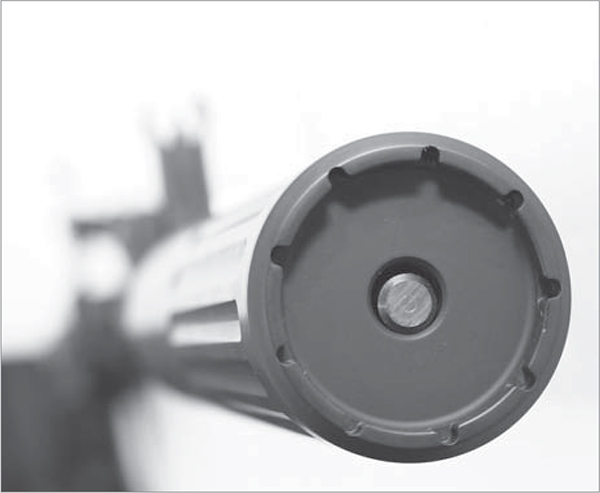
Another partial fail. At this rate, will anything work?
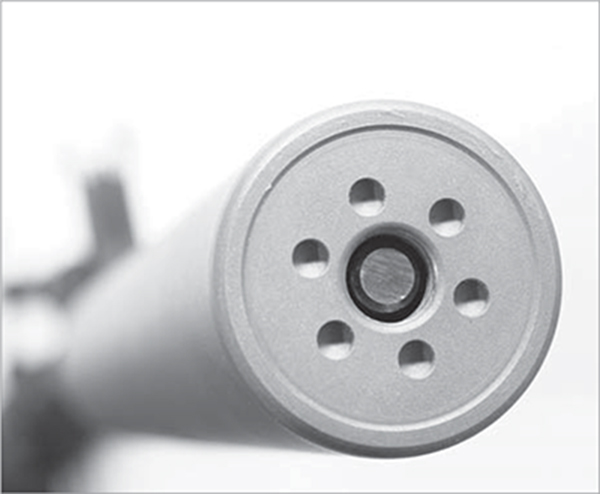
Success! This passes, and it works.

Wow, simply wow. This failed so badly we had to come up with a new term, the “Epic Fail.”